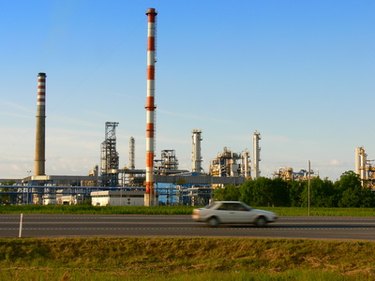
We think about bacteria as harmful, disease-causing, invisible creatures. But actually, only a few species are dangerous. The majority of bacteria are good, and without them, life on Earth wouldn't be possible.
Bacteria help degrade dead animals and plants and bring valuable nutrients back to Earth. Some species also help clean harmful pollutants out of the environment in a process called bioremediation. By using bioremediation techniques, toxic substances such as heavy metals and petroleum are no longer harmful to the environment. Bacteria are also cheap and accurate sensors of toxic chemicals.
Video of the Day
Video of the Day
Significance
The most numerous organisms in the soil are bacteria. They are a necessary part of nutrient, or biogeochemical, cycles in which carbon, nitrogen, sulfur and phosphorus are recycled between living beings and the environment. Without these cycles, there would be no exchange of elements that are the backbone of proteins, sugars and fats—there would be no life.
Bacteria as Biosensors
According to the U.S. Environmental Protection Agency, U.S. industries generate 292 million tons of hazardous waste each year, with at least 40 million tons released into the environment. Traditional chemical analyses for determining and locating toxic waste are expensive and often not accurate. Therefore, scientists have designed biosensors, which are genetically modified bacteria that can locate pollutants.
Biosensors do not require costly chemicals or equipment, and they work within minutes. Some bacteria emit light when they encounter a certain toxic chemical. Others emit light as long as they are healthy but stop if they have been killed by toxins.
Bacteria as Pollution Fighters
Heavy metals from industry and toxic synthetic organic chemicals, including pesticides, petroleum products, explosives and flame retardants, pose serious environmental and health risks. They enter soil, air and water and are extremely resistant to natural breakdown processes. Bioremediation uses certain bacteria that digest toxic substances and convert them into less harmful substances. To some degree, bioremediation occurs naturally, but it is usually enhanced by adding bacterial "food," such as phosphorus and nitrogen, which make bacteria grow better and clean chemicals more effectively. Bioremediation is usually less expensive and less labor-intensive than traditional technologies.
Specifically Selected Bacteria

Industrial pollution and oil spills are often of a magnitude that requires enhanced bioremediation, where researchers select bacteria that grow specifically on a certain pollutant or genetically modified bacteria that can metabolize a specific pollutant. The addition of such bacteria is called bioaugmentation, which is used to clean up oil spills in water. Also, researchers have genetically altered radiation-resistant bacteria to make them more useful in cleaning up sites contaminated with radioactive materials.
Significance
Good bacteria are necessary cleaners of toxic waste, and without them many accidents in the environment would turn into catastrophes. In 1989, the ship Exxon Valdez hit a reef near the shoreline of Prince William Sound, Alaska, causing one of the greatest oil spills in history. Researchers are still working on how to completely clean these pristine waters. In the first five years after the accident, the oil was disappearing at a rate of about 70 percent due to successful bioremediation.
- “International Journal of Environment Research and Public Health”; Plant-Associated Bacterial Degradation of Toxic Organic Compounds in Soil; Martina McGuinness, Ph.D., and David Dowling, Ph.D.; Aug. 12, 2009
- “Current Opinion in Biotechnology”; Microbial Communities in Oil-Contaminated Seawater; Harayama Shigeaki, Ph.D., Kasai Yuki, Ph.D., Hara Akihiro, Ph.D.; June 2004
- EPA: Hazardous Waste
- EPA: Bioremediation
- EPA: Cleanup
- Science Daily: Bioremediation
- Exxon Valdez
Is this an emergency? If you are experiencing serious medical symptoms, please see the National Library of Medicine’s list of signs you need emergency medical attention or call 911.